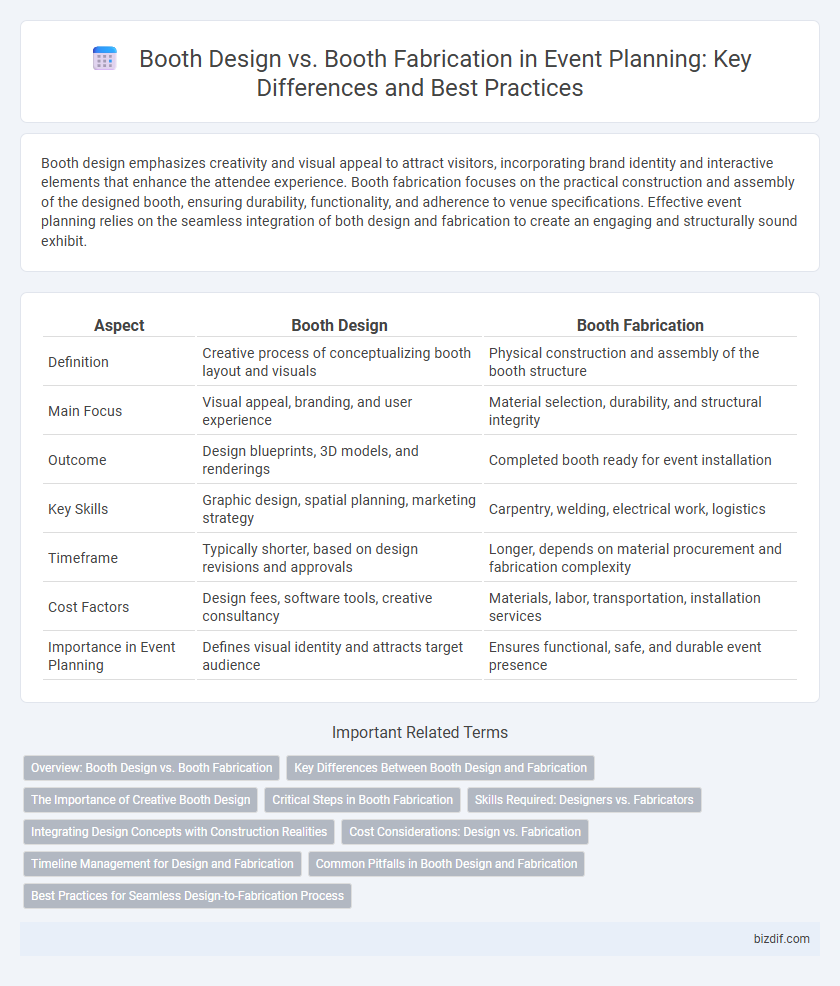Booth design emphasizes creativity and visual appeal to attract visitors, incorporating brand identity and interactive elements that enhance the attendee experience. Booth fabrication focuses on the practical construction and assembly of the designed booth, ensuring durability, functionality, and adherence to venue specifications. Effective event planning relies on the seamless integration of both design and fabrication to create an engaging and structurally sound exhibit.
Table of Comparison
| Aspect | Booth Design | Booth Fabrication |
|---|---|---|
| Definition | Creative process of conceptualizing booth layout and visuals | Physical construction and assembly of the booth structure |
| Main Focus | Visual appeal, branding, and user experience | Material selection, durability, and structural integrity |
| Outcome | Design blueprints, 3D models, and renderings | Completed booth ready for event installation |
| Key Skills | Graphic design, spatial planning, marketing strategy | Carpentry, welding, electrical work, logistics |
| Timeframe | Typically shorter, based on design revisions and approvals | Longer, depends on material procurement and fabrication complexity |
| Cost Factors | Design fees, software tools, creative consultancy | Materials, labor, transportation, installation services |
| Importance in Event Planning | Defines visual identity and attracts target audience | Ensures functional, safe, and durable event presence |
Overview: Booth Design vs. Booth Fabrication
Booth design involves creating the visual concept, layout, and branding elements to attract and engage attendees at events. Booth fabrication focuses on the physical construction and assembly of the booth, using materials and techniques to bring the design to life. Both stages are crucial for delivering an effective and functional exhibition space that meets event goals and logistical requirements.
Key Differences Between Booth Design and Fabrication
Booth design involves the creative process of planning the visual layout, aesthetics, and functionality of an exhibition space, focusing on branding elements, color schemes, and customer engagement strategies. Booth fabrication refers to the physical construction and assembly of the booth according to the design specifications, including materials selection, structural integrity, and installation logistics. Key differences lie in design emphasizing conceptual creativity and marketing goals, while fabrication centers on technical execution and production feasibility.
The Importance of Creative Booth Design
Creative booth design plays a crucial role in attracting attendees and differentiating your brand at events by integrating visually compelling graphics, interactive elements, and strategic layout. While booth fabrication focuses on the construction and physical assembly, innovative design ensures the booth communicates your message effectively and engages visitors. Prioritizing creativity in booth design maximizes return on investment through increased foot traffic and memorable brand experiences.
Critical Steps in Booth Fabrication
Booth fabrication involves critical steps such as detailed design approval, material selection, precise construction, and quality control to ensure structural integrity and aesthetic appeal. Custom fabrication requires collaboration with skilled craftsmen to translate design concepts into functional, durable booth components. Timely coordination of logistics and installation is essential to meet event deadlines and optimize the attendee experience.
Skills Required: Designers vs. Fabricators
Booth design requires creative skills, an understanding of branding, and proficiency in design software like AutoCAD or SketchUp to create visually appealing and functional layouts. Fabricators need technical skills in carpentry, welding, and materials handling, along with expertise in using tools and machinery to bring the design to life. Collaboration between designers and fabricators ensures the final booth is both aesthetically impressive and structurally sound for event success.
Integrating Design Concepts with Construction Realities
Booth design emphasizes creative concepts, aesthetics, and brand messaging to attract attendees, while booth fabrication focuses on translating these designs into functional, structurally sound constructions. Integrating design concepts with construction realities ensures that the final booth is visually compelling, compliant with venue regulations, and built within budget constraints. Collaboration between designers and fabricators optimizes materials, durability, and assembly processes, enhancing the overall event impact.
Cost Considerations: Design vs. Fabrication
Booth design costs primarily involve conceptualizing visuals, layouts, and branding elements, often requiring skilled graphic designers and 3D modelers. Booth fabrication expenses cover materials, construction labor, and technical installation, typically representing a larger portion of the overall budget due to physical production complexities. Optimizing cost efficiency demands balancing high-impact design innovation with practical fabrication methods to maximize ROI in event marketing campaigns.
Timeline Management for Design and Fabrication
Effective timeline management in event planning requires distinguishing between booth design and booth fabrication phases, as each demands distinct scheduling considerations. Booth design involves conceptualization, client approvals, and iterative modifications, typically requiring 2-4 weeks for finalization. Booth fabrication follows design approval and focuses on material sourcing, construction, and quality control, often spanning 3-6 weeks to ensure timely event setup without last-minute delays.
Common Pitfalls in Booth Design and Fabrication
Common pitfalls in booth design and fabrication include inadequate space planning, which leads to overcrowding or underutilized areas, and poor material selection that compromises durability and visual appeal. Miscommunication between designers and fabricators often results in delays and cost overruns, while neglecting compliance with trade show regulations can cause last-minute redesigns or penalties. Prioritizing detailed planning, clear collaboration, and adherence to event standards ensures a functional and attractive booth that maximizes visitor engagement.
Best Practices for Seamless Design-to-Fabrication Process
Effective booth design integrates clear communication of brand identity with practical considerations for fabrication materials and methods. Collaboration between designers and fabricators early in the process ensures accurate translation of digital concepts into physical structures, reducing costly revisions. Utilizing 3D modeling and prototype testing enhances precision and streamlines the transition from design to fabrication, promoting a seamless event setup experience.
Booth design vs booth fabrication Infographic

 bizdif.com
bizdif.com